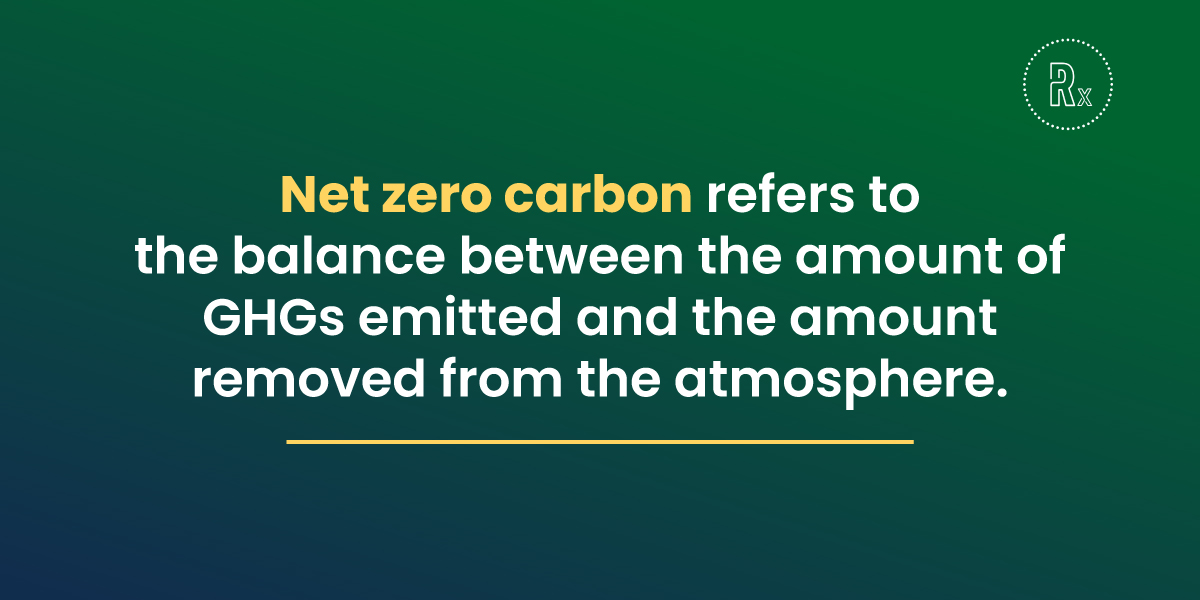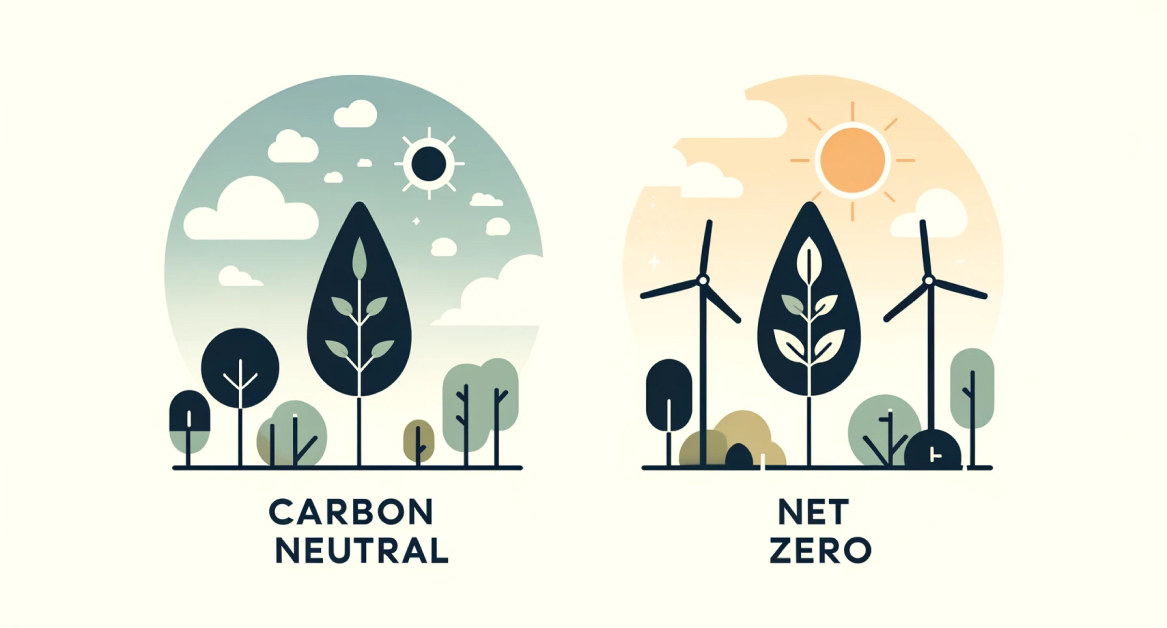The global scientific community agrees that to avoid severe climate impacts, human-caused carbon dioxide (CO2) emissions must decrease by approximately 45% from 2010 levels by 2030 and achieve net zero by 2050. Since global warming correlates directly with cumulative CO2 emissions, any level above zero will continue to drive planetary warming.
This goal is not just a trend but a necessary pivot towards a sustainable and environmentally responsible future. The journey towards net zero carbon is complex, encompassing a range of strategies from regenerative soil to energy efficiency, and it’s vital to understand its multifaceted nature.
What is Net Zero Carbon
Definition and concept
Net zero carbon refers to the balance between the amount of greenhouse gas emissions produced and the amount removed from the atmosphere. In essence, it’s about achieving a state where our activities no longer contribute to the net increase in atmospheric carbon dioxide (CO2) levels.

This balance is crucial in stabilizing global temperatures and limiting global warming to 1.5 degrees Celsius, a target set by the Paris Agreement to prevent the most catastrophic impacts of climate change.
💡 Extra reading: Carbon Neutral vs. Net Zero Explained
The science behind Net Zero Carbon
At the core of net zero carbon is the science of greenhouse gas emissions, primarily carbon dioxide. These emissions are the main drivers of climate change, trapping heat in the Earth’s atmosphere and leading to rising global temperatures.
Therefore, the science behind achieving net zero revolves around reducing these emissions through various means like emission reduction, energy efficiency, and adopting renewable energy sources.
Historical context and global agreements
The historical journey towards net zero carbon is deeply intertwined with global efforts to address climate change. Key milestones include the Kyoto Protocol and the Paris Agreement, which have galvanized international commitment to reducing greenhouse gas emissions.
The Paris Agreement, in particular, has been pivotal in shaping the net zero targets, with countries committing to limit global warming to well below 2, preferably to 1.5 degrees Celsius, compared to pre-industrial levels.
Setting Net Zero Carbon targets
1. Long-term vs. short-term goals
In the pursuit of net zero carbon, setting both long-term and short-term goals is essential. Long-term goals provide a vision and ultimate destination for industries and nations, aligning with global efforts to limit climate change. These often involve significant transformations in energy systems and industrial processes.
Short-term goals, on the other hand, are like stepping stones, achievable and actionable targets that make the long-term vision attainable. They include measures like incremental improvements in energy efficiency or gradual reductions in GHG emissions.
2. Industry-specific targets
Different industries have unique paths to achieving net zero carbon, reflecting their specific emission profiles and opportunities for reduction. For instance, the agricultural sector, which is both a source and a sink for greenhouse gases, faces distinct challenges and opportunities in reaching net zero. Strategies like regenerative farming practices, which enhance soil health and sequester carbon, are pivotal in this sector.
3. Steps to establishing a Net Zero Carbon roadmap
Establishing a net zero carbon roadmap involves several key steps. Initially, it requires a comprehensive assessment of current carbon footprints and emission sources. This is followed by setting clear, measurable targets aligned with scientific recommendations to limit global warming.
The next step involves developing and implementing strategies tailored to specific industry needs, such as adopting renewable energy sources or improving supply chain sustainability.
Lastly, continuous monitoring and adjusting of these strategies ensure they remain effective and responsive to new developments in technology and policy.
Strategies for achieving Net Zero Carbon in agriculture
Agriculture plays a unique role in the quest for net zero carbon. As a sector that directly interacts with natural resources and ecosystems, it has the potential to significantly influence carbon emissions and sequestration. Here are some key strategies:
- Regenerative agricultural practices: Embracing regenerative techniques, such as cover cropping, crop rotation, and reduced tillage, can enhance soil health. Healthy soils are vital for carbon sequestration – capturing carbon dioxide (CO2) from the atmosphere and storing it in the ground.
- Carbon insetting in supply chains: This involves integrating carbon offset activities within the agricultural supply chain itself rather than through external projects. For example, sustainable practices, like afforestation or sustainable land management, can be implemented directly on the farm.
- Energy efficiency and renewable energy: Transitioning to renewable energy sources like solar or wind power reduces reliance on fossil fuels, thus reducing greenhouse gas emissions. Enhancing energy efficiency in agricultural processes also plays a critical role.
- Innovative farming technologies: Utilizing data-driven technologies can optimize farming practices, reducing waste and improving resource efficiency. This includes precision agriculture, which uses data analytics to optimize planting, watering, and harvesting.
- Greenhouse gas emission measurement and management: Regular monitoring of GHG emissions enables farmers to understand their impact and identify areas for improvement. Tools and platforms like those being developed by RegenX can aid in this critical assessment.
Measuring progress and accountability
Effectively measuring progress towards net zero carbon in agriculture is vital for understanding the impact of implemented strategies and ensuring accountability. This involves several key components:
- Impact measurement tools: Robust tools and methodologies should be utilized for measuring improvements in livelihoods, regenerative impacts, and carbon offsets at the farm level. These measurements should encompass not only carbon dioxide emission reductions but also other greenhouse gas emissions.
- Transparent reporting: Regular and transparent reporting of progress is crucial. This includes disclosing both successes and challenges and offering a realistic view of the journey toward net zero. Stakeholders, including investors and consumers, are increasingly demanding such transparency.
- Third-party verification: Engaging independent bodies to verify reported data adds credibility to the claims.
- Continuous improvement: The journey to net zero is not static. It requires ongoing adaptation and improvement, integrating new scientific findings and technologies. Continuous learning and innovation are key to staying on course.
- Stakeholder engagement: Effective progress measurement and accountability also depend on engaging all stakeholders, including farmers, investors, and consumers. Creating a community around net zero goals can foster shared responsibility and collective action.
Taking action toward a sustainable future
As we’ve explored, the journey to net zero carbon is multifaceted and requires concerted efforts across various sectors, especially agriculture. Embracing regenerative practices, leveraging technology, and measuring progress rigorously are key to making meaningful strides in this direction.
RegenX is offering innovative solutions, such as eco-agriculture financing and technological advancements, to make the goal of net zero carbon more attainable for farmers and investors alike.



